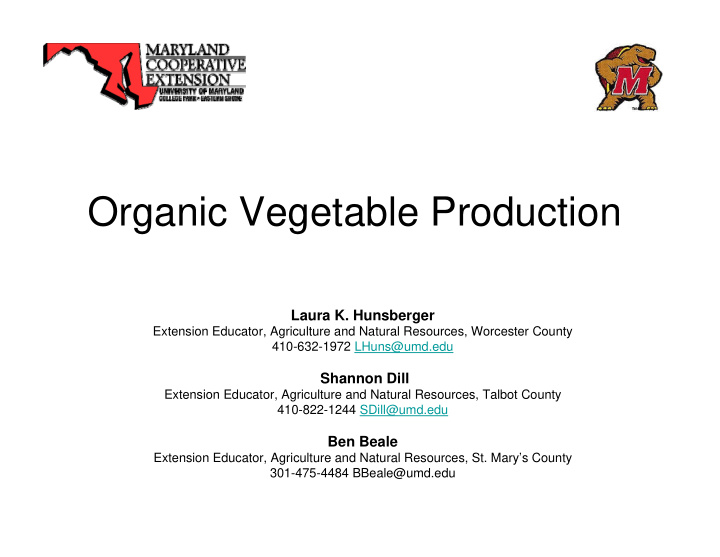



Organic Vegetable Production Laura K. Hunsberger Extension Educator, Agriculture and Natural Resources, Worcester County 410-632-1972 LHuns@umd.edu Shannon Dill Extension Educator, Agriculture and Natural Resources, Talbot County 410-822-1244 SDill@umd.edu Ben Beale Extension Educator, Agriculture and Natural Resources, St. Mary’s County 301-475-4484 BBeale@umd.edu
Presentation Overview • Trends in Organic Production • Soil Health and Fertility • Pest Management • Marketing • Pricing Organic Products
Introduction • U.S. organic food sales have grown between 17 and 21 percent each year since 1997. • Conventionally grown food sales that have grown only 2 to 4 percent a year for the same time period. • Organic food sales now represent approximately 2 percent of U.S. food sales • Organic production is a ‘system’ approach that improves the condition of the soil and reduces soil erosion.
Soil Health and Fertility • The use of crop rotation is critical in organic production to break up the pest cycle between families of plants and other susceptible hosts • Organic producers can provide nutrients to their crops through the use of composted manures, cover crops and approved blended materials • Organic growers are required to improve the biological productivity of their soil – cover crops, while providing organic matter and erosion control, can also provide nutrients (mostly Nitrogen).
Pest Management • Insects are managed through – enhancement of biodiversity (increasing natural enemy populations – providing habitat – crop rotation – adjusting planting dates – use of approved chemical products. • Weed management is obtained through – use of cover crops – mulches – tillage – flaming – manual removal – The manual control of weeds in an organic system is one of the factors that increase the cost of raising vegetables organically
Pest Management • Diseases are managed through – Use of resistant varieties – Cultural controls (prpoer water usage, removal of diseased plant materials, adjusting planting dates) – Approved Products (www.omri.org)
Marketing Organic Products • The majority of locally grown organic products are sold directly to the consumer through farmers markets, roadside stands and CSAs (Community Supported Agriculture) • There is an increasing organic wholesale market to health stores and supermarkets due to consumer demand – Selling to these larger markets often takes higher quantity of production • It is necessary for organic producers to educate the consumer on the principles of organic growing and why purchasing organic provides a benefit
Pricing Organic Products • Organic offers a “premium” that consumers may be willing to pay for the organic label – Organic production is more labor intensive therefore prices should reflect that cost • Determining the Price for your Product: – Determine the value of your inputs (physical and purchased) – Know what the market can bear (is there an over-production of organic zucchini?) – The Organic Price Report (http://www.rodaleinstitute.org/Organic-Price-Report) allows for the comparison of organically grown vegetables in several wholesale markets in the United States
Additional Resources • USDA National Organic Program http://www.ams.usda.gov/nop/index.htm • Organic Materials Review Institute www.omri.org • Organic Trade Association www.ota.com • USDA Economic Research Service http://www.ers.usda.gov/data/organic/ • Organic Farming Research Foundation http://www.ofrf.org/ • Appropriate Technology Transfer for Rural Areas http://www.attra.ncat.org/ • New Farm magazine www.newfarm.org
Recommend
More recommend